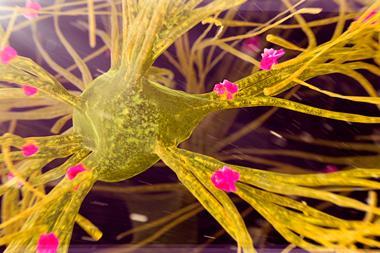Readers discuss antidepressants, industrial disasters and what Humphry Davy inhaled
Antidepressants in balance
In this interdisciplinary field one has to propose comments based on partial knowledge, or else stay silent. However, I think the recent article on antidepressants distorts too many aspects, including the invented conflict between biochemical and social views. Not a word on the suffering and death.
It’s always been known that you can’t easily explore serotonin’s neurotransmitter function in intact humans. Most body serotonin is in the gut lining, from which it is easily released, and blood platelets dump their load at, so to say, the sight of a needle. With neurochemical transmission, the synaptic cleft is usually tightly shielded from its surroundings, so the little neurotransmitter that leaks out gives little information.
Since the 1960s, numerous clinicians have insisted that effective treatment of affective disorders requires both a drug and a lot of social and psychological care (not classical psychotherapy). This was the basis of the opposition of Medical Research Council research unit director Alec Coppen to policies on lithium in bipolar disorder that arose from the 1968 scandal: ‘One lesson we learned is that simply prescribing treatment is not effective.’ Half a century later, too many people still can’t get their heads round this fact.
A lot is known about how the serotonin transporter works, though anyone who has tried to isolate functional membrane proteins will know why there are gaps. Crystals usable for XRD could be obtained only for a non-functional genetically modified protein. The notion that the transporter ‘mops up serotonin molecules’ is outdated: electrophysiological studies show that reuptake accounts for a large part of the depolarising ion current and thus participates synchronously in the discharge.
The September 2004 news item about placebo responses to selective serotonin reuptake inhibitors (SSRIs) should definitely not have been recalled. The meta-analysis in question refers to the rare trials that focused on primary care; it’s obviously too soon at that point for confident diagnosis, and the presenting condition might be self-limiting. Uncomplicated cases of the common cold always ‘respond’ to placebo! Uncritical reporting of valid but untypical data like this to a ‘lay’ audience can only feed the anti-SSRI rhetoric that’s being denounced.
Christopher Lee MRSC
Via email
Diet and Alzheimer’s
I read the article on Alzheimer’s disease with great interest, having lost six friends from the disease in the last 20 years. The article concentrates on the amyloid and tau hypotheses and drug treatments for people who have contracted the disease.
I was surprised that the article did not mention the large amount of work done over the last 36 years on memory and ageing and the prevention of Alzheimer’s disease by David Smith, founder of the Oxford Project to Investigate Memory and Ageing.
In 2020 Smith gave a lecture (viewable on YouTube) to the Food For the Brain charity that reviews the studies published in the last 20 years on diet and dementia from which he concludes his preventive dietary recommendations.
Christopher Pearce MRSC CChem
Via email
ICI explosion
I am writing in response to the articles in Chemistry World on the explosion at the Nypro plant near Flixborough in 1974. In 1969, cyclohexane was also the cause of a large explosion at ICI Wilton on Teesside, which led to two deaths and multiple casualties, of which my father, a site engineer, was one.
ICI attributed the cause of the fire to a diesel high-lift truck whose engine became filled with leaked cyclohexane. The cyclohexane ignited, blowing up the vehicle and a nearby cyclohexane holding tank. The explosion ripped through the plant blowing windows out of the office blocks and led to a widespread fire.
Trevor Kletz, a former safety adviser at ICI, notes in his book By Accident that while this cause of ignition was made public, the cause of the leak was not and ‘no one asked how the leak occurred’. Kletz states that the leak resulted because a slip-plate designed to isolate part of the operating line was missing, and this allowed cyclohexane to escape into the air and to be drawn into the engine.
An independent report prepared by John Davidson of the University of Leicester, which I have seen but which was not made available to the public, gives much more detail of the incident.
It’s unclear if any lessons were learned by Nypro from the ICI explosion five years previously, but the question could be asked that if more details of the event had been released, could the Flixborough fire have been prevented?
Patrick Walter states that employees of the Nypro plant declined to talk and those who did gave harrowing accounts. This is a pertinent reminder of the personal cost of large scale disasters such as this. As the daughter of a survivor of the Wilton fire who was left disabled from the burns he sustained, the long-term effects spread like ripples through the lives of the families involved.
Amanda Graham MRSC
Via email
Clearing the air
With respect to Robert Haresnape, I think the quote from Humphry Davy’s notebook reads ‘The feeling produced by breathing about 7 quarts of nitrous phosoxyd mingled with 7 quarts of atmospheric air was indeed most delightful.’ In addition, I don’t believe that in Davy’s time PH3 was known as phosphine but rather as ‘phosphoretted hydrogen’.
Barry Knight
St Albans, UK
The ‘illegible’ words in Davy’s notebook are surely ‘atmospheric air’ and certainly not ‘phosphine’. Inhalation of seven quarts (8 litres) of the latter would more likely have proved fatal than delightful.
Dick Martin
Via email
DDT’s secrets
I believe I can add a bit more information to the recent article and correspondence regarding the insecticide DDT (Chemistry World, July 2024, p4). My father worked at the Pilkington/Sullivan plant of ICI in Widnes as a security officer until his retirement in the early 1950s. Many employees of Pilks (as it was known) were accustomed to bring home samples of DDT which was made there and used it for treating the insects that infested the low cost housing in the area. According to my father the DDT unit in Widnes was secretive during the war years and was known as the Hush-Hush plant because of the use of DDT for military purposes.
Tom Griffiths FRSC
Harpenden, UK












No comments yet